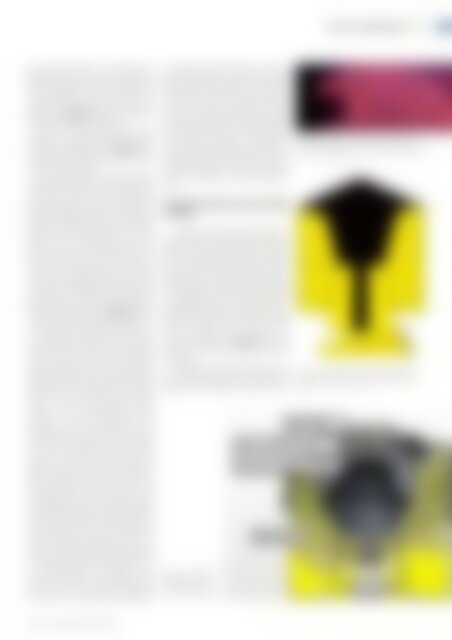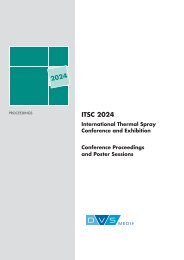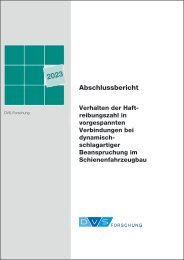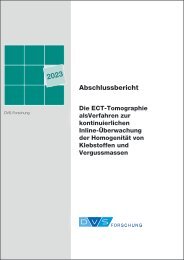STEEL + TECHNOLOGY 01/2020 EXTRACT
STEEL + TECHNOLOGY 01/2020 EXTRACT
STEEL + TECHNOLOGY 01/2020 EXTRACT
Create successful ePaper yourself
Turn your PDF publications into a flip-book with our unique Google optimized e-Paper software.
<strong>STEEL</strong> <strong>TECHNOLOGY</strong> | 39<br />
kg of ladle well filler. To examine the<br />
applied ladle well filler in the well block,<br />
this took place at the end of the refractory<br />
linings lifespan and the well block was<br />
carefully recovered at the start of the relining<br />
process. Figure 3 shows the ladle well<br />
filler covered backup well block.<br />
Result of the ideal application of ladle<br />
well filler is a material cone, peaking 15-18<br />
cm above the ladle bottom. Figure 4 illustrated<br />
the backup well block after the application<br />
of ladle well filler.<br />
After the application of ladle well filler<br />
to the backup system, the steel ladle went<br />
through a routine production cycle lasting<br />
approximately 3-4 hours and tapping via<br />
the main slide gate system. After tapping,<br />
remaining slag was poured out and the<br />
ladle was then transported to the relining<br />
facility to cool. Subsequently the worn<br />
refractory lining was removed and the<br />
backup well block was recovered. During<br />
the removal of the well block from the bottom<br />
lining, flowable ladle well filler was<br />
lost and only solidified structures could be<br />
recovered. The well block containing solidified<br />
material was then bisected vertically<br />
along the casting channel. Figure 5 shows<br />
one of the recovered backup well blocks.<br />
Starting the examination from the bottom<br />
of the casting channel, the first significant<br />
feature is the dome spanned cavity<br />
in the well block. This cavity contained<br />
flowable ladle well filler until the backup<br />
slide gate system was removed and the<br />
well block was excavated from the ladle<br />
bottom lining. The shown ladle well filler<br />
starts to form liquid phases above<br />
1,500°C, thus the flowable mass was<br />
exposed to lower temperatures. The<br />
dome above the cavity consists of a layer<br />
of sintered ladle well filler with a thickness<br />
of 3 – 6 cm. This layer formed during the<br />
cooling of the highly viscous silica melt<br />
phase covered in earlier publications.<br />
Overlying the sintered dome is a layer of<br />
steel pervaded by slag inclusions and<br />
shrinkage cavities. The boundary reactions<br />
between well block, steel and ladle<br />
well filler are subject of ongoing research.<br />
A comparison between the material cone<br />
after addition and the sintered dome<br />
shows a significant reduction in size, i.e.<br />
roughly a third of the added ladle well filler<br />
was eroded through physical mechanisms<br />
or thermochemical processes. The<br />
amount of erosion in the industrial trials<br />
varied over a wide range, determined by<br />
the duration of the secondary metallurgical<br />
treatment and the alloys in the produced<br />
steel quality. This dynamic process<br />
determines the progression of the surface<br />
of the dome into the casting channel. A<br />
more pronounced erosion of the ladle well<br />
filler and a further progression into the<br />
casting channel lead to a smaller diameter<br />
of the dome that can then withstand higher<br />
ferrostatic pressures consequently<br />
reducing the free opening rate. This is a<br />
possible explanation for the correlation of<br />
treatment duration and free opening rate<br />
which is described in numerous publications.<br />
Interaction between steel and ladle<br />
well filler<br />
The effect of the steel grade on the erosion<br />
of ladle well fillers was examined in<br />
laboratory tests conducted by Purmetall<br />
and Forschungsgemeinschaft Feuerfest<br />
with the goal to develop ladle well fillers<br />
especially suited for the conditions during<br />
the production of particular steel grades.<br />
To investigate the reactions between steel<br />
and ladle well filler a new crucible test, distinguished<br />
by the direct exposure of ladle<br />
well filler to liquid steel in an inert atmosphere<br />
at 1,600°C for a duration of two<br />
hours, was developed. Figure 6 shows an<br />
example of the two component crucible<br />
test setup.<br />
To recreate the specific working conditions,<br />
different ladle well fillers and steel<br />
grades were combined in these two com-<br />
Figure 5. Bisected<br />
well block from<br />
the industrial trial<br />
(Picture: Purmetall)<br />
Figure 3. Backup well block with added<br />
ladle well filler shortly before EAF tapping<br />
(Picture: Purmetall)<br />
Figure 4. Illustration of the backup well<br />
block after addition of 50kg of ladle well<br />
filler (Picture: Purmetall)<br />
<strong>STEEL</strong> + <strong>TECHNOLOGY</strong> 2 (<strong>2020</strong>) No. 1


















